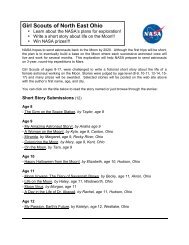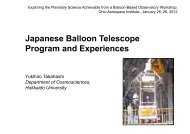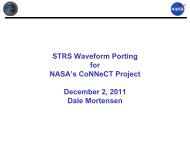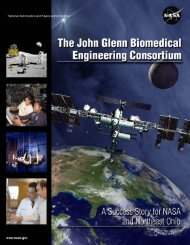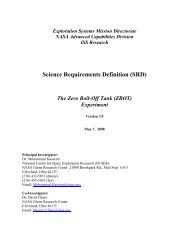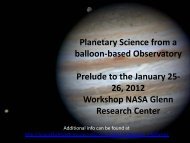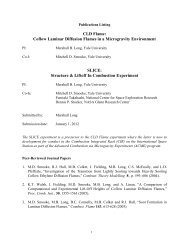Amusement Park Physics With a NASA Twist - Space Flight Systems ...
Amusement Park Physics With a NASA Twist - Space Flight Systems ...
Amusement Park Physics With a NASA Twist - Space Flight Systems ...
You also want an ePaper? Increase the reach of your titles
YUMPU automatically turns print PDFs into web optimized ePapers that Google loves.
Carousels—Nonattending Students<br />
Ground Measurements<br />
Determine the revolutions per minute of the carousel.<br />
1.<br />
Stand on the ground in front of the carousel and locate a<br />
particular spot on the ride. Make sure that you have a way to<br />
remember that spot. Position yourself directly in front of it.<br />
Measuring the angle of the carousel pole<br />
2.<br />
If the ride is not moving, wait until it begins and has made<br />
several turns. When the point that you have selected is<br />
directly in front of you, start your stopwatch and keep it<br />
running for 5 revolutions. Total time for 5 revolutions in<br />
seconds: 90<br />
4.<br />
5.<br />
Calculate the time for 1 revolution. This is called the period<br />
of rotation of the ride. Time for 1 revolution (period of<br />
rotation):<br />
To find the revolutions per minute of the ride, divide 60 by<br />
the period of rotation, since there are 60 seconds in 1<br />
minute. Revolutions per minute:<br />
Carousel pole<br />
Carousels—Nonattending Students<br />
Ride Measurements<br />
1. There is a “lean” of the benches and on the poles that support the animals. When the ride is<br />
stationary, use your altitude tracker to determine the angle that an animal in the outer row makes<br />
with the vertical. While holding the tracker vertically, place it against the animal’s support pole,<br />
reading the angle between the washer and the zero mark on the tracker. Angle = 8°<br />
2. Measure the angle that an animal in the inner row makes with the vertical. Angle =<br />
3°<br />
3. Which animal has a larger angle, the one located in the inner row or the one in the outer row<br />
4. Do the same measurements on the very same animals while the ride is in motion.<br />
Inner angle: 0° Outer angle: 0°<br />
5. How do the results of angle measurements compare when looking at stationary ride animals<br />
versus moving ride animals Explain your answer.<br />
94<br />
<strong>Amusement</strong> <strong>Park</strong> <strong>Physics</strong> <strong>With</strong> a <strong>NASA</strong> <strong>Twist</strong><br />
EG–2003–03–010–GRC



